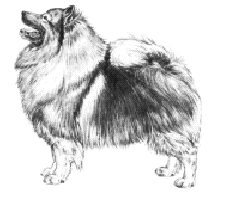Keeshond
General Information - Keeshond

Group:
Non
Sporting
Size:
Medium
Lifespan:
12-14 years
Exercise:
Medium
Grooming:
Medium
Trainability:
Medium
Watchdog Ability:
Very high
Protection Ability:
Very low
Area of Origin:
The Netherlands
Date of Origin:
1700s
Other Names:
Wolfspitz
Original Function:
Barge watchdog
History
The Keeshond is a member of the Spitz family of northern dogs. Originally most popular in the Netherlands, it descended from the German Wolfspitz and thus is a close relative to the Pomeranian. Throughout the 18th century, the breed was used in the Netherlands as a "dog of the people." As a good watchdog, companion, and swimmer, it was commonly found in villages, farms and on the barges in the Dutch canals. During a period of unrest in Holland, the dog became the mascot for the Patriot party, which was led by Kees de Gyselaer, and thus the name "dog of Kees" or "Keeshond" was assigned to the breed. Although it was exhibited at Dutch shows in the late 1800s, the breed did not gain popularity elsewhere until the 1920s. Today the breed is appreciated by those who want a good family pet.
Temperament
The friendly Keeshond loves nothing more than being a part of the family. A swimmer, companion and watchdog, Keeshonds are lively and warm and love bouncing around with children.
Upkeep
This is a lively breed that can have its exercise needs met with moderate exercise. A good walk on leash, combined with a vigorous game, can satisfy its needs. It can live outside in temperate or cool climates, but it is such a sociable dog that it prefers to share its life with its family. The double coat needs brushing once or twice weekly, and more when shedding.
Keeshond
A breed standard is the guideline which describes the ideal characteristics, temperament, and appearance of a breed and ensures that the breed is fit for function with soundness essential. Breeders and judges should at all times be careful to avoid obvious conditions and exaggerations, as well as being mindful of features which could be detrimental in any way to the health, welfare or soundness of this breed.
Breed Standard - Keeshond
 General Appearance:
General Appearance: A short, compact body, alert carriage, foxlike head; small pointed ears; a well:feathered, curling tail, carried over the back, hair very thick on the neck, forming a large ruff; head, ears and legs covered with short thick hair. Dogs should move cleanly and briskly (not lope like a German Shepherd) but movement should be straight and sharp. Dogs should show boldly.
Head and Skull: Head well proportioned to the body, wedge:shaped when seen from above; from the side showing definite stop. Muzzle should be of medium length, neither coarse nor snipy.
Eyes: Dark with well-defined spectacles.
Ears: Small and well set on head, not wide and yet not meeting.
Mouth: Should be neither over nor undershot, upper teeth should just overlap under teeth and should be white, sound and strong (but discolouration from distemper not to penalize severely).
Forequarters: Forelegs feathered, straight, with good bone and cream in colour.
Hindquarters: Hind legs should be straight, showing very little hock and not feathered below the hock. Cream in colour.
Feet: Round and cat-like with black nails.
Tail: Tightly curled, a double curl at the end is desirable. Plume to be white on the top where curled, with black tip.
Coat: Dense, and harsh (off-standing), dense ruff and well feathered, profuse trousers; a soft, thick, light-coloured undercoat. Coat should not be silky, wavy or woolly, nor should it form a parting on the back.
Colour: Should be wolf, ash-grey; not all black or all white, and markings should be definite.
Weight and Size: The ideal height is 45.7 cm (18 in) for dogs and 43.2 cm (17 in) for bitches, but type is of more importance.
Faults: Light eyes, prominent eyes. Curly or wavy tendency in coat. Silky coat. Absence of spectacles. Nervous demeanour. Drop ears. Whole white foot or feet. Black marks below the knee, pencilling excepted. White chest. Apple head or absence of stop.
Note: Male animals should have two apparently normal testicles fully descended into the scrotum.
DNZ No 740
Copyright Dogs New Zealand
01 Jan 2002
Any departure from the foregoing points should be considered a fault and the seriousness with which the fault should be regarded should be in exact proportion to its degree and its effect upon the health and welfare of the dog and on the dog’s ability to perform its traditional work.




